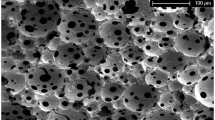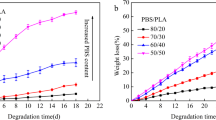Abstract
Microporous membranes for tissue engineering were produced from new biodegradable polyurethane based on hexamethylene diisocyanate, poly(ε-caprolactone) diol and 1,4:3,6-dianhydro-d-sorbitol. The interconnected pores had an average size in the range of 5–100 μm. The tensile strength at break, the Young’s modulus and elongation at break of the membranes were 3.2 ± 0.3 MPa, 25.2 ± 1.5 MPa and 190 ± 12%, respectively, while nonporous foils from the same polymers had a tensile strength at break of 40 ± 2 MPa, a Young’s modulus of 91 ± 6 MPa, and an elongation at break of 370 ± 10%. The membranes were incubated for 10 days in a 2.65 vol% solution of long-chain plant polyprenol in n-hexane to promote their interaction with cells and tissues. The polyprenol was isolated from leaves of Magnolia cobus and was a mixture of prenol-10 and prenol-11. The prenol-impregnated membranes and nonimpregnated membranes (control) were tested in cell culture to assess whether impregnation has a beneficial effect on cell-material interaction. The cells used in the test were chondrocytes isolated from the articular-epiphyseal cartilage of leg bones of 5-day-old inbred LEW rats. The time of culture was 2 and 5 weeks. Both, the nonimpregnated and impregnated polyurethane membranes supported attachment and growth of rat chondrocytes. The cells firmly attached to the surface of the microporous membranes, invaded the pores and maintained the round shape characteristic for chondrocyte-like-morphology. Abundant fibrillar extracellular matrix produced by the cells resembled the network formed by chondrocytes in vivo. The cells produced relatively more extracellular matrix in the membranes impregnated with polyprenol than in the control membranes. Impregnation of polyurethane scaffolds with biologically active amphiphilic polyprenols may be a route to facilitate the cell–material interaction.








Similar content being viewed by others

References
S. GOGOLEWSKI, A. J. PENNINGS, E. LOMMEN, P. NIEUWENHUIS and CH. R. H. WILDEVUUR, Makromol. Chem. Rapid Commun. 4 (1983) 213
S. GOGOLEWSKI and A. J. PENNINGS, Makromol. Chem. Rapid Commun. 4 (1983) 675
S. GOGOLEWSKI and A. J. PENNINGS, Artif. Organs 7 (1983) 30
S. GOGOLEWSKI and G. GALLETTI, Colloid Polymer Sci. 264 (1986) 854
S. GOGOLEWSKI, G. GALLETTI and G. USSIA, Colloid Polym. Sci. 265 (1987) 774
G. GALLETTI, S. GOGOLEWSKI, G. USSIA and F. FARUGGIA, Ann. Vasc. Surg. 3 (1989) 236
G. GALLETTI, G. USSIA, F. FARUGGIA, E. BACCARINI and S. GOGOLEWSKI, Ital. J. Surg. Sci. 19 (1989) 121
S. GOGOLEWSKI, in “Desk Reference of Functional Polymers. Syntheses and Applications”, Edited by: R. ARSHADY (American Chemical Society, Washington, DC, 1996) p. 657
K. GORNA and S. GOGOLEWSKI, in “Synthetic Bioabsorbable Polymers for Implants”, Edited by: C. M. AGRAWAL, J. E. PARR and S.T. LIN (American Society for Testing and Materials, West Conshohocken, PA, 2000) p. 39
K. GORNA, PhD Thesis, Technical University of Lodz, Lodz, Poland (2002)
K. GORNA and S. GOGOLEWSKI, Polymer Degrad. Stab. 79 (2003) 475
K. GORNA and S. GOGOLEWSKI, Polymer Degrad. Stab. 75 (2002) 113
K. GORNA and S. GOGOLEWSKI, J. Biomed. Mater. Res. 79 (2006) 128 Published Online: 15 Jun 2006, DOI: 10.1002/jbm.a.30708
K. GORNA and S. GOGOLEWSKI, Transactions, European Society for Biomaterials Meeting. Sorrento, Italy, September 11–15 (2005)
K. GORNA and S. GOGOLEWSKI, J. Biomed. Mater. Res 67A (2003) 813
K. GORNA, S. POLOWINSKI and S. GOGOLEWSKI, J. Polym. Sci: A. Polym. Chem. 40 (2002) 156
F. W. HEMMING, in “Biochemistry”, Edited by: T. W. GOODWIN, series 1, Vol. 4 (Butterworths, London, 1974) p. 39
T. CHOJNACKI, E. SWIEZEWSKA and T. VOGTMAN, Chem. Scripta 27 (1987) 209
T. CHOJNACKI and E. SWIEZEWSKA, in “Dolichols Polyprenols and Derivatives, Collection of Polyprenols”, 1st edn. (Warszawa, 1995) p. 17
N. K. KHIDYROVA and Kh. M. SHAKHIDOYATOV, Chem. Nat. Compd. 38 (2002) 107
W. KOROHODA, J. STANISZ, A. STANISZ, T. CHOJNACKI, G. PALAMARCZYK and A. RADOMIŃSKA-PYREK, Eur. J. Cell Biol. 21 (1980) 239
J. BURGOS, F. HEMMING, J. F. PENNOCK and R. A. MORTON, Biochem. J. 88 (1963) 470
R. WELLBURN and F. HEMMING, Phytochemistry 5 (1966) 969
P. R. CULLIS and M. J. HOPE, in “Biochemistry of Lipids” (Vance & Vance, Elsevier, Amsterdam, 1991) p. 17
N. F. HADLEY, in “The Adaptive Role of Lipids in Biological Systems” (Wiley, New York, 1985), p. 57
T. M. KOYAMA, C. R. STEVENS, E. J. BORDA, K. J. GROBE and D. A. CLEARY, Chem. Educ. 4 (1999) 12
Acknowledgements
One of the authors (K. Walinska) would like to thank Professor Tadeusz Chojnacki, Professor Ewa Świeżewska and co-workers from the Department of Lipid Biochemistry, IBB PAS, Warsaw, for making possible the isolation of polyprenols; Professor Stanisław Moskalewski and Doctor Ewa Jankowska from The Medical University of Warsaw, for making possible the cell culture experiments; and Professor Elżbieta Wyroba and co-workers from the Nencki Institute of Experimental Biology, PAS, Warsaw, for making possible SEM evaluation of cell cultured scaffolds.
Author information
Authors and Affiliations
Corresponding author
Rights and permissions
About this article
Cite this article
Walinska, K., Iwan, A., Gorna, K. et al. The use of long-chain plant polyprenols as a means to modify the biological properties of new biodegradable polyurethane scaffolds for tissue engineering. A pilot study. J Mater Sci: Mater Med 19, 129–135 (2008). https://doi.org/10.1007/s10856-007-3146-y
Received:
Accepted:
Published:
Issue Date:
DOI: https://doi.org/10.1007/s10856-007-3146-y



